Hawaii men’s basketball: 100th Season Best-Team Bracket, Round of 16, Day 4
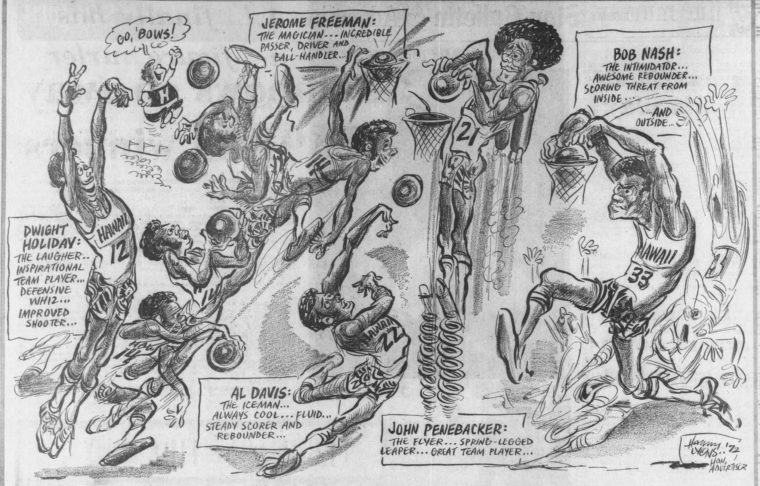
Day 4 of the Hawaii basketball 100th Season Best-Team Bracket, the last day of the Round of 16, could begin to help us get a better feel for something.
Was the Hawaii Warrior World tournament committee wrong to make the “Fabulous Five” NCAA Tournament team of 1971-72 the No. 2 seed, and not the No. 1? After all, that team was long considered the best in program history, and you’ll read why below.
How the votes go in their first-round matchup with a solid team of much more recent vintage — the 2013-14 Rainbow Warriors — could give us a feel for how successive matchups might go next week and beyond, should the “Five” advance, of course.
As always, you can vote in the embedded Twitter polls below or at the Warrior World Twitter page directly. Voting opens up at 6 a.m. (HST) Sunday and you’ll have 24 hours to vote.
Voting for DAY 2 and DAY 3 of the Round of 16 are in the books, with the 1996-97 (6 seed), 2001-02 (3 seed), 1997-98 (4 seed) and 1970-71 (5 seed) teams prevailing, joining top seed 2015-16 and No. 8 1993-94. So far, there hasn’t been a lower seed to upset a higher seed, although the 70-71 Fab Five team had to work at it, with only a 60-40 split against Benjy Taylor’s 2014-15 squad.
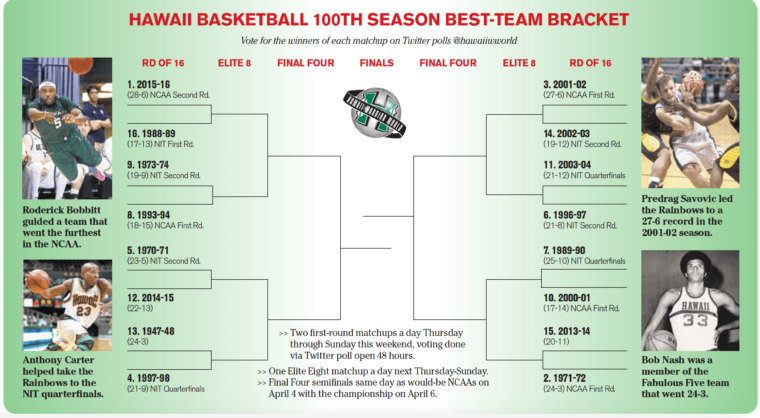
In the final matchups of the Round of 16 on Sunday: It’s one of the winningest teams in program history, the 1989-90 NIT squad led by Chris Gaines, against the late-blooming 2000-01 NCAA Tournament team with a heavily international cast. Then it’s the 2013-14 team of Isaac Fotu and Christian Standhardinger getting the first crack at the aforementioned 71-72 “Green Machine,” better known as the “Fabulous Five.”
MATCHUP NO. 1
No. 7 1989-90 (25-10, NIT quarterfinals)
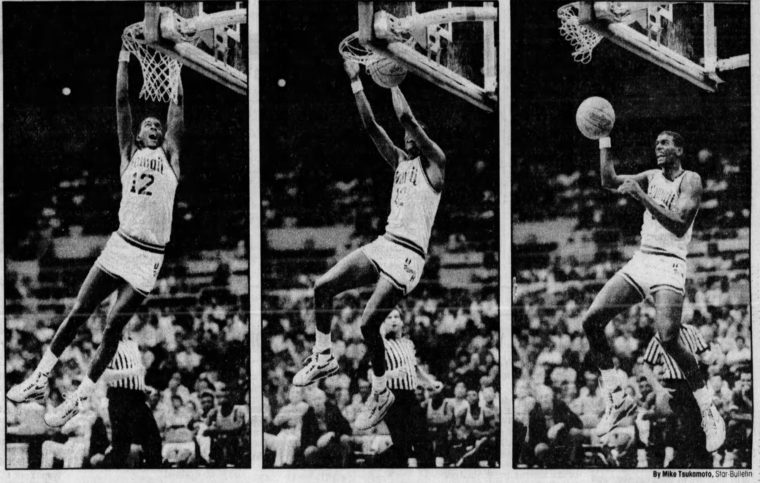
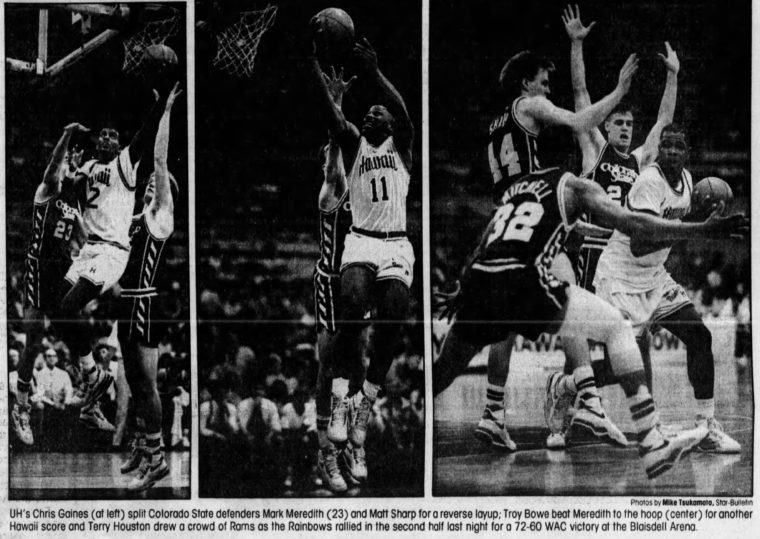
This crew started the season 10-1 — with the lone loss to Kansas State in the Great Alaska Shootout — before losing 87-75 to Duke. Yes, Christian Laettner and Bobby Hurley were just pups, but they did go to the NCAA championship game three months later, and UH gave them all they could handle in the final of the Rainbow Classic; All-WAC first-team guard Chris Gaines kept UH in it with a game-high 26 points, but Duke pulled away in the closing minutes. Throughout the season, led by guards Gaines, Troy Bowe and Phil Lott and a front line of Terry Houston, Vincent Smalls and Cliff Beaubrun, the Rainbows were not flamboyant or statistically impressive as a unit. But they were gritty, especially in tournaments. They went 10-6 in the WAC regular season, tying for third, and made it to the WAC tournament final, then came within one win of the NIT semifinals and Madison Square Garden (after wins against Stanford, 69-57, and a strong Long Beach State squad, 84-79, at the Blaisdell). However, UTEP at the Haskins Center in the WAC tourney and New Mexico at The Pit in the NIT quarters were too much to overcome. Despite that, it was a season of redemption for the late Gaines, who after missing the spring semester of his junior season due to academic ineligibility, came back strong and scored a then-record 616 total points in the season (17.6 per game) to become UH’s all-time leading scorer at 1,734, surpassing Fabulous Fiver John Penebacker (1,519). His season points stand at No. 2 now, behind only the 626 of Anthony Harris in 1995-96. While not a gifted 3-point shooter — Gaines shot .303 from distance for his career — he converted 47.9% for his four-year tenure from the field, most impressive for a guard. He got to the line often, too, and converted a UH career-record 84.8 percent of those attempts to become the all-time free-throw maker (442) as well. UH set a record for wins in a season that would last 12 years.
Roster: Beaubrun, Arlen Bento, Bowe, Gaines, Mike Gilless, Houston, Joe Hudson, Jim Lactaoen, Lott, Andrew McGuire, Wendall Navalta, Bob Robinson, Tim Shepherd, Smalls.
VS.
No. 10 2000-01 (17-14, NCAA first round)
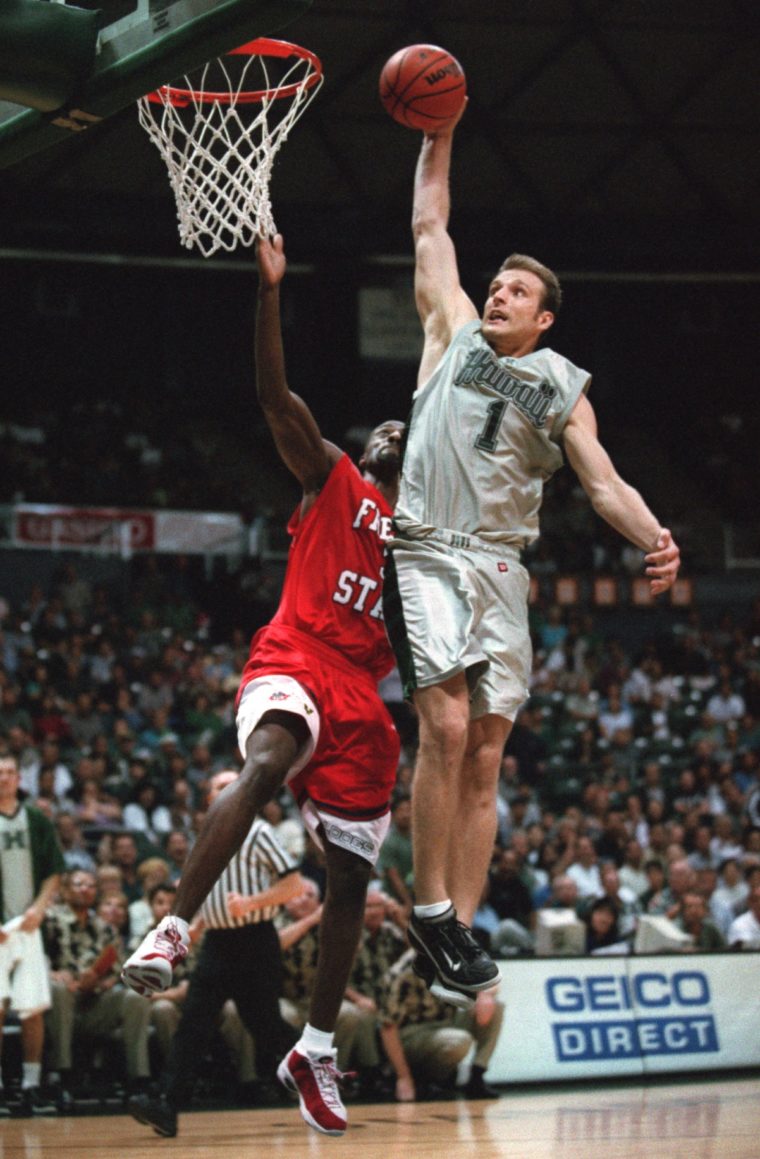
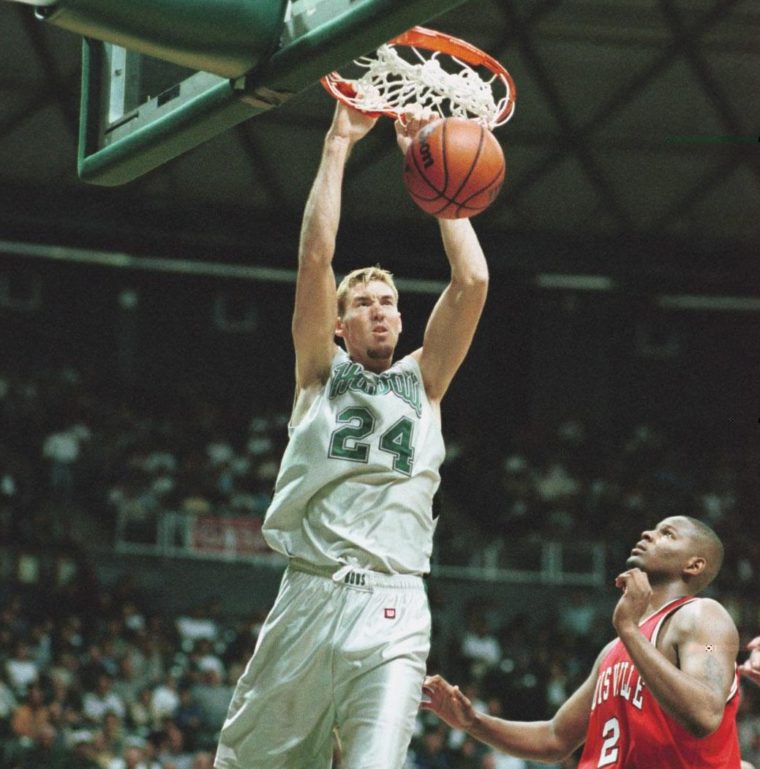
The ‘Bows were mediocre until two lineup changes late in the regular season and then in the postseason. Israeli freshman center Haim Shimonovich was unavailable until the last nine games due to having played among professionals in earlier years, and a redshirt freshman, guard Carl English, sat on the bench behind David “Jeep” Hilton and Ricky Terrell until the conference tournament — where English exploded for 25 points in the championship game against host Tulsa and was the tournament MVP in the 78-72 overtime win. A key English bank shot, on a play drawn up for Predrag “I Am Savo” Savovic, sent the game to OT and cemented the coming-out party for the Canadian freshman. That victory, just UH’s second all-time WAC tournament championship, punched UH’s ticket to the NCAA Tournament, despite its 8-8 WAC regular-season record. Savovic, who transferred into the program from UAB, was the secondary offensive option the season before, behind Marquette Alexander, but emerged as an All-WAC first-teamer at 17.6 points per game. The Rainbows had plenty of scoring punch with Savovic, English, mobile forward Troy Ostler (15.9), sharpshooter Mike McIntyre, rugged Mindaugas Burneika, up-and-coming Phil Martin and veteran Nerijus Puida. Once he could play, the 6-foot-10, 245-pound Shimonovich gave UH the big body it needed under the basket. It took a while to figure out — UH was 10-12 overall after an 86-63 loss at Fresno State on Feb. 11 — but once it did, they rolled to wins in seven of the next nine. Their WAC tournament run as the 5 seed (still the lowest seed UH has worn in winning a conference tournament) included romps over fourth-seeded TCU (99-79) and top-seeded Fresno State (76-67) en route to the tight final against second-seeded Tulsa. In punching their their first NCAA ticket since 1994, when they lost Syracuse, the 12th-seeded Rainbows learned they’d face … fifth-seeded Syracuse (ranked No. 17 overall). This time, the score was 79-69. However, most of this heavily international group would return the following year and set new benchmarks for the program.
Roster: Burneika, English, Todd Fields, Hilton, Ryne Holliday, Martin, McIntyre, Lane O’Connor, Ostler, Puida, Bosko Radovic, Savovic, Shimonovich, Lance Takaki, Terrell.
Day 4 of the #HawaiiMBB 100th season Best-Team Bracket is underway.
>> No. 7, 1989-90 (Chris Gaines, Terry Houston, Phil Lott)
VS.
>> No. 10, 2000-01 (Predrag Savovic, Troy Ostler, Nerijus Puida)
Info/rosters for both teams here: https://t.co/G6SDmiYEym
— Hawaii Warrior World (@hawaiiwworld) March 22, 2020
——————
MATCHUP NO. 2
No. 15 2013-14 (20-11)
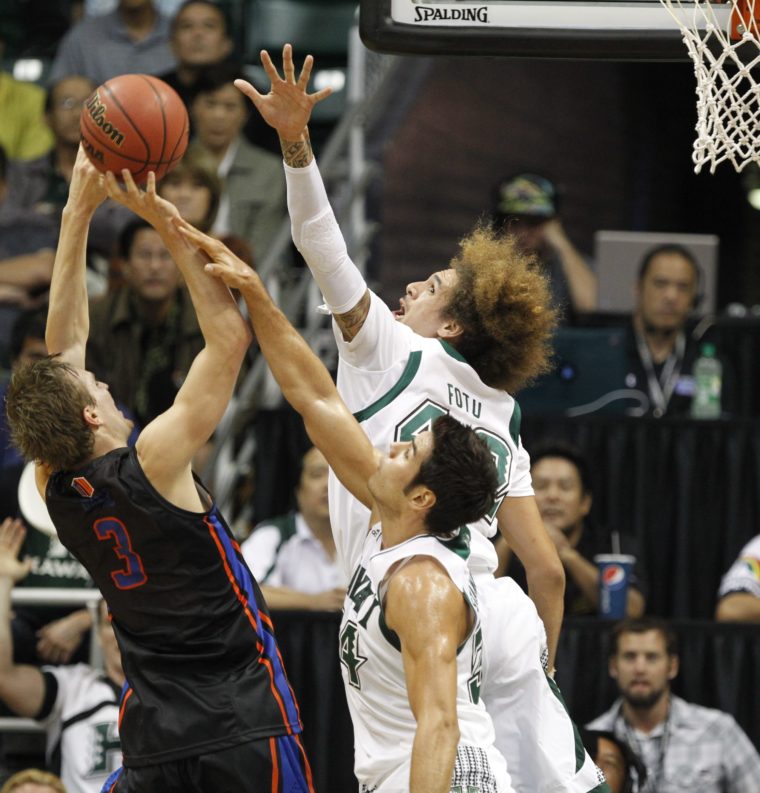
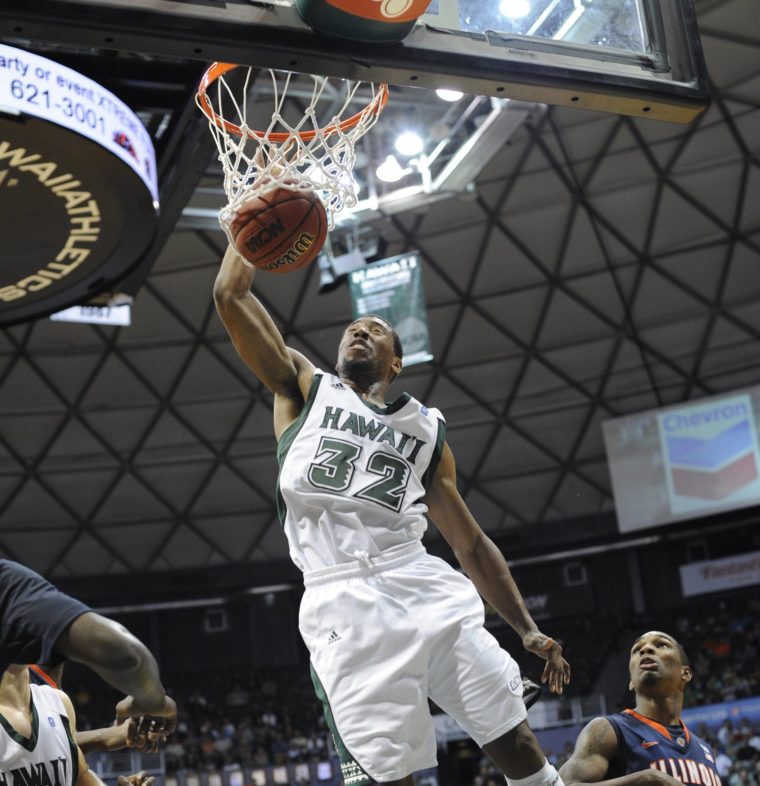
Nobody knew this would be the last hurrah for Gib Arnold. Year 3 of the Arnold era featured a talented but crowded frontcourt between Vander Joaquim, Christian Standhardinger and freshman phenom Isaac Fotu. But, with Joaquim walking out the door by Arnold Year 4, it turned out less was more in the guard-heavy Big West as both the irrepressible, hustling Standhardinger (18.1 points, 8.4 rebounds per game) and efficient, prodigious Fotu (14.9, 6.1, 58.4 percent shooting) picked up All-Big West first-team awards, a rare boon for a fourth-place team that went 9-7 in conference play. In fact, it was the first time UH ever placed two players on a conference first team in the same year, though it happened again two years later. Lithe 7-footer Davis Rozitis garnered acclaim in his own way, too, for flustering teams as the head of the “point zone” at the top of the key, a defensive scheme UH tailored specifically to his abilities off the bench. When it came to guard play, UH was stocked as well. Point guard Keith Shamburger got in his one year at UH after transferring from San Jose State and before transferring to Missouri. Junior college transfers Brandon Spearman and Garrett Nevels were capable wing defenders and scorers. Defensive-minded Quincy Smith was the sixth man as a sophomore coming out of City College of San Francisco. Aaron Valdes, a former water polo standout, was an emerging raw talent as a redshirt freshman who could leap out of the gym. Even walk-on Drybe Enos out of Kamehameha even got some run. UH averaged an even 80.0 points per game, the program’s highest mark in 40 years, in notching UH’s first 20-win season in a decade. Its starting five nearly all averaged double-figure scoring (Shamburger would finish at 9.3 per game). But an upset loss to Cal State Northridge in the Big West tournament first round at Honda Center, 87-84 in overtime, wound up being Arnold’s final game as UH coach; he was fired days prior to the start of 2014-15 while his program was under NCAA investigation for improper benefits for student-athletes, among other things. That would be the final collegiate game for Fotu, as well, as the New Zealander got wrapped up in the investigation. He decided to leave school and launch what has become a very successful pro career overseas. As one of the only other lingering effects of the NCAA’s probe that actually stuck, UH had to officially vacate its 20 wins from this season, and all but one win from 2012-13. However, for these purposes, every win counts. Why? Because we say so, that’s why.
Roster: Enos, Fotu, Jack Hackman, Michael Harper, Brandon Jawato, Stefan Jovanovic, Nevels, Rozitis, Shamburger, Smith, Spearman, Standhardinger, Mike Thomas, Valdes.
VS.
No. 2 1971-72 (24-3, NCAA first round)
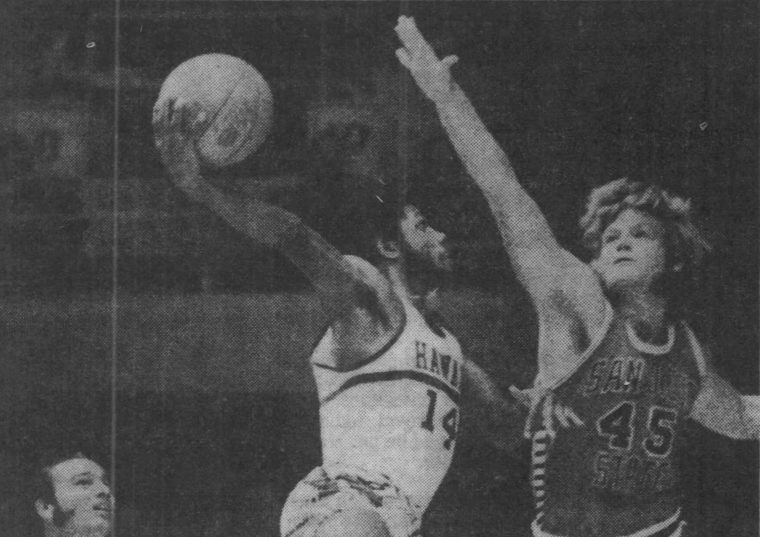
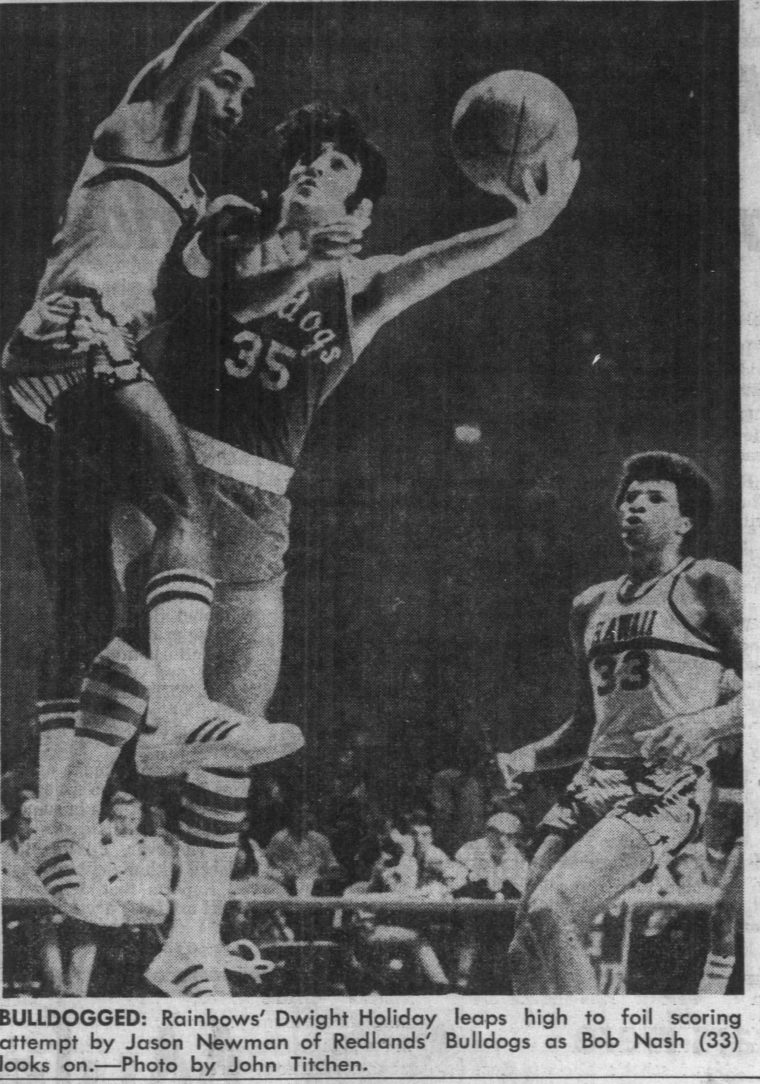
The Fabulous Five returned intact after its electrifying 23-5 debut of 1970-71, and the second edition was just as thrilling — crowds responded with fervor and the 7,500-seat Blaisdell Arena (then called the Honolulu International Center) sold out 19 times in 19 home games. This time 6-foot-8 Bob Nash was the leading scorer (18.2) and rebounder (14.4), swapped from 6-7 big man Al Davis (18.9) the season before. “Little General” Jerome Freeman (5.3 assists per game), at 5-9, was team captain for the second straight year. John Penebacker (13.9 ppg), a 25-year-old Air Force veteran and 6-2 leaping pivotman, and 6-4 speed merchant Dwight Holiday (16.7) remained highly productive. Subs like Todd Huber, Mike Kendall and Artie Wilson contributed. UH’s first NCAA Tournament team went 19-0 at home and 5-2 on the road in the regular season, with the lone losses by 10 points at Loyola Marymount and one point at Westmont. Coach Red Rocha’s squad, even with the quicker pace of play in this era, averaged a ridiculous 91.7 points per game, which easily remains the program record. The ‘Bows bested eventual national runner-up Florida State twice at home, including once by forfeit when Seminoles coach Hugh Durham refused to walk off the court after getting ejected with his team trailing 30-10. FSU was No. 9 and No. 14 for those two matchups; UH was previously 0-23 all-time against Associated Press ranked teams. That helped vault UH into the rankings for the first time in program history, at No. 18. UH remained in the top 20 the rest of the season, cresting at a program all-time best No. 12 on March 7. It built up to UH’s inaugural NCAA meeting with 17-9 Weber State in Pocatello, Idaho, for the right to play Bill Walton and Coach John Wooden’s eventual six-time national champion UCLA team in the second round of the 25-team field. But favored Hawaii was crushed by the Wildcats, 91-64, with Nash held to seven points against a 2-1-2 zone defense and Bob Davis going off for 32 for the Wildcats. … It was far from the end for Nash, though, as he was drafted by the Detroit Pistons with the ninth overall selection of the NBA Draft, and also played with Kansas City in the NBA. He later was an assistant and head coach at UH and his jersey (No. 33) was retired in 2020. Nash’s sublime rebounding average remains the single-season record, and he owns the career average mark as well (13.6). His legendary 30-board game against Arizona State in the 1971 Rainbow Classic championship is another mark that won’t be bested anytime soon — the exclamation point for UH’s first All-American, who also became the first to average a double-double for a season. Davis would leave with a 17.1 scoring average for his two-year Rainbows career, setting the benchmark in the all-college opponent era. He remains fourth all-time in average. The Fabulous Five lived on as a unit, often returning to Hawaii for exhibitions and reunions. UH’s 49-8 record during the “Fabulous Five” era remains the best in winning percentage (.860) for UH over any two-year span.
Roster: Mike Blackshire, Tyrone Bradshaw, Davis, Freeman, Holiday, Huber, Kendall, Nash, Penebacker, Mark Skillicorn, Jim Wienstroer, Charlie Williams, Wilson.
Day 4 of the #HawaiiMBB 100th season Best-Team Bracket is underway.
>> No. 15, 2013-14 (Christian Standhardinger, Isaac Fotu, Brandon Spearman)
VS.
>> No. 2, 1971-72 (Bob Nash, Al Davis, Dwight Holiday)
Info/rosters for both teams here: https://t.co/G6SDmiYEym
— Hawaii Warrior World (@hawaiiwworld) March 22, 2020
——————
Brian McInnis and Dave Reardon assembled the season summaries. Curtis Murayama designed the 100th season bracket.
There’s a small error in the caption for the photo Crafty “Little General” reads Jerome Holiday should be Jerome Freeman.
Good eye! Thanks H-Man, I let the webmaster know and it will be fixed.
Fixed, thanks again.
When’s the next match-up?
Thursday.